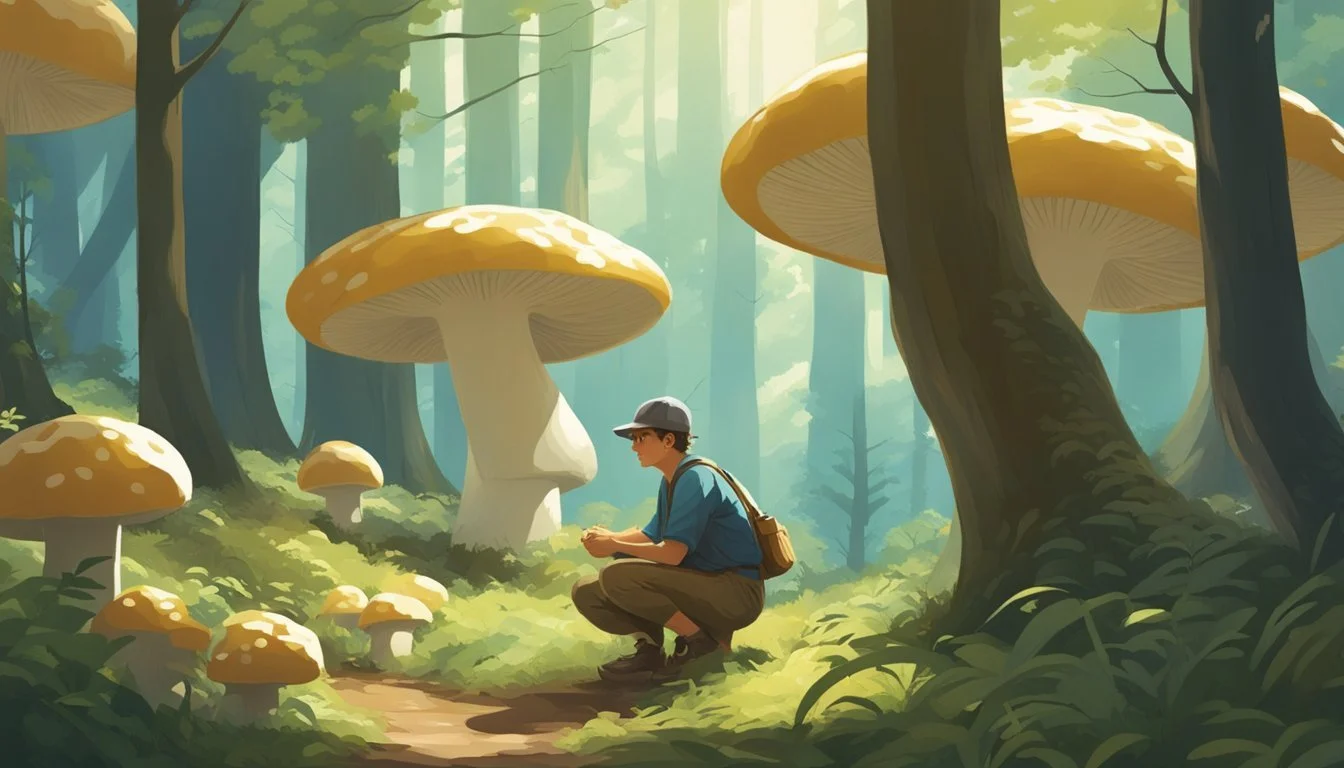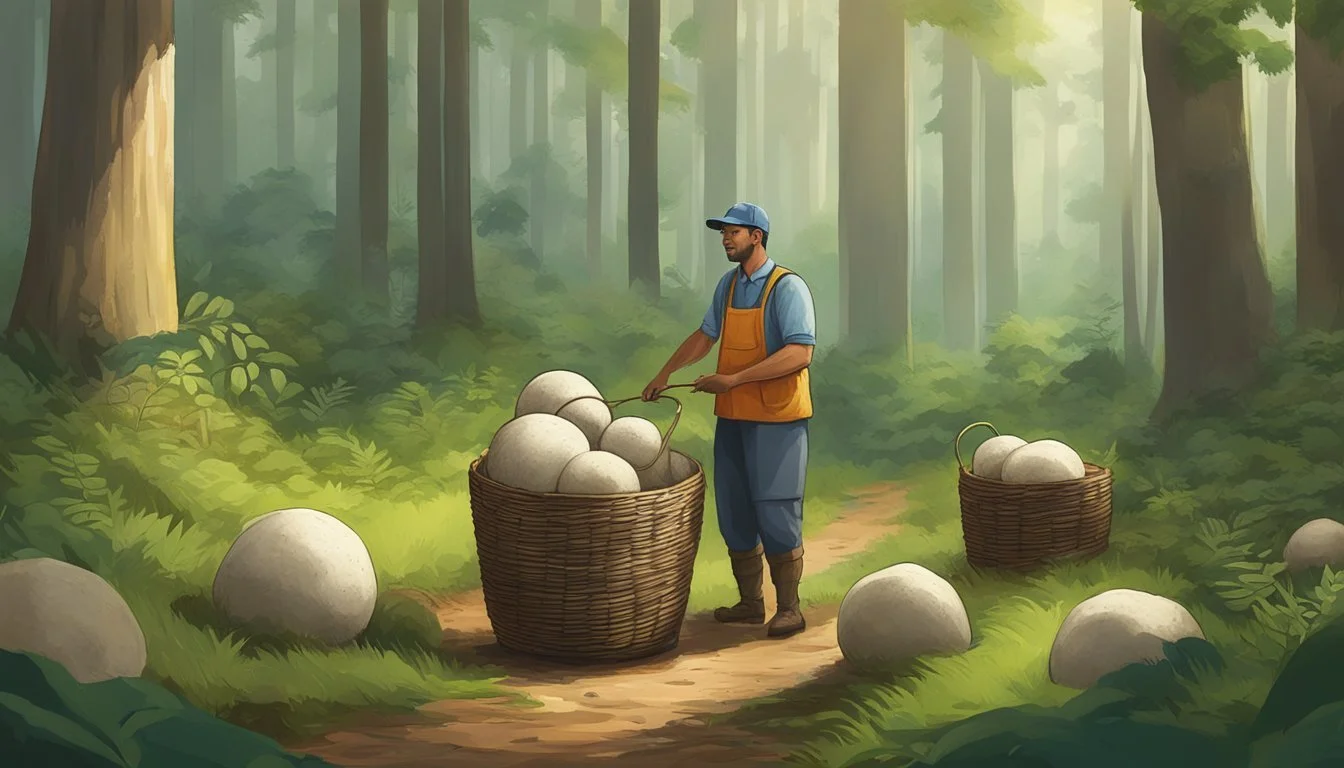Foraging and Harvesting Giant Puffballs
A Safe and Sustainable Guide
This Article is Part of Our Guide on Foraging and Harvesting Wild Mushrooms
Giant puffball mushrooms (What wine goes well with mushrooms?) are an intriguing find for foragers due to their impressive size and distinctive appearance. These fungi can be identified by their spherical shape and lack of a stem, typically growing between 10 and 70 centimeters in diameter. Found across the central and eastern United States, Canada, Europe, and other regions of the world, giant puffballs thrive in areas with rich soil and ample moisture.
Foraging for giant puffball mushrooms requires a keen eye and knowledge of their life cycle to ensure that only edible specimens are collected. These mushrooms are best harvested when they are young and the flesh is pure white, as older puffballs with yellowing or browning flesh can indicate spore development and potential spoilage. Collecting puffballs during late summer to autumn, especially after periods of rain, can yield the most success.
Harvesting giant puffballs is not only about timing but also about sustainability. Foragers must be cautious to avoid over-harvesting and to maintain the natural ecology of the foraging area. Once harvested, the mushrooms can be prepared in various ways, such as slicing and sautéing them, often resulting in a meaty and delicious component to many culinary dishes. Whether seasoned simply with salt and pepper or enhanced with garlic and white wine, giant puffballs offer foragers a rewarding experience both in the search and in the kitchen.
Giant Puffballs are Commonly Found in these US-States
Giant puffballs (Calvatia gigantea) are a type of mushroom that can be found growing wild in various regions across the United States. They typically grow in meadows, pastures, and open woodlands. Some states where giant puffballs are known to occur include:
Giant puffballs can also be found in other countries, such as Canada, Mexico, Europe, and Asia.
Identifying Giant Puffballs
Foragers seeking giant puffball mushrooms must be equipped with knowledge to correctly identify these edible fungi and differentiate them from toxic species. Correct identification ensures both the safety and enjoyment of the foraging experience.
Visual Characteristics
Giant puffball mushrooms are distinct in their appearance. They typically exhibit round to oval shapes and can vary in size, generally measuring 10 to 70 cm in diameter. The skin of the puffball is smooth, and the mushrooms are often found in shades of white or light tan. An essential identifying feature is the lack of gills; instead, giant puffballs have a pure white interior when cut open.
Habitats and Growing Conditions
Giant puffballs thrive in a variety of habitats, commonly sprouting in meadows, fields, and deciduous forests. They prefer moist soil conditions and often grow in the presence of decaying wood, which serves as a source of nutrients. They may also be found forming a fairy ring, a circular pattern that emerges from an expanding fungal mycelium underground.
Distinguishing From Toxic Look-Alikes
To ensure safety, foragers must distinguish giant puffballs from toxic species. One potential look-alike is the amanita mushroom, which is highly toxic. Unlike the giant puffball, young amanita mushrooms can have a bulbous base and may display developing gills. Amanitas may also come with a universal veil that leaves remnants on the mushroom cap, while puffballs do not. A reliable method to avoid mistaking the two is to slice the mushroom open; an edible puffball will have a consistent pure white interior with no structures resembling gills or caps within, whereas a section through an immature amanita may reveal the silhouette of a mushroom.
Foraging Best Practices
Foraging for giant puffball mushrooms is an activity that calls for precision and environmental respect. A successful forager knows the importance of recognizing optimal conditions and adhering to sustainable practices.
Ideal Locations and Conditions
Giant puffballs thrive in areas with rich soil and sufficient moisture. They are often found in grassy areas, including meadows and fields, which provide the ideal environment for their growth. Foragers are most likely to encounter these mushrooms in areas with ample open space, as they require room to expand. It is important to inspect each mushroom closely to ensure it has not begun to spoil or host insects.
Look for: Open grassy areas
Inspect for: Freshness and absence of insects
Timing and Seasonality
The timing for foraging giant puffballs is typically late summer to early autumn. This coincides with periods after rain when puffballs are most likely to appear. Foragers should monitor weather conditions and plan their excursions after sufficient rainfall, as this increases their chances of a successful harvest.
Best time to forage: After rainfall in late summer and early autumn
Monitor: Weather patterns
Responsible Harvesting
When foraging wild mushrooms such as giant puffballs, it is crucial to harvest responsibly to ensure sustainability. Only collect what is needed for personal use and leave smaller, immature specimens to grow. This not only allows for continued natural propagation but also supports the local ecosystem.
Collect: Only what is needed
Leave: Smaller, immature puffballs to grow
Harvesting and Storage Techniques
Successful harvesting and storage of puffball mushrooms hinge on appropriate techniques to ensure safety and maximize longevity. This involves careful collection, thorough cleaning, and selecting the right storage methods.
Collection Methods
Harvesters should identify puffball mushrooms at the right stage of growth—when they are firm and the inside is white. It's vital to harvest before they turn yellow or brown, which indicates spore development. Utilizing a gentle twist and pull method, they should remove the mushroom from the soil to prevent damage to both the fungus and its environment.
Cleaning and Preparing
Once collected, puffballs require immediate cleaning. They should be wiped with a soft brush or damp cloth to remove dirt and debris. If cutting is necessary, only a clean, sharp knife should be used to avoid bruising the flesh. After cleaning, they can be sliced into pieces that are convenient for cooking or storage.
Storage Solutions
For short-term storage, puffball mushrooms can be kept in a refrigerator. They should be placed in a paper bag or wrapped in a paper towel to absorb excess moisture, then stored in the main compartment of the refrigerator. For long-term preservation, options include:
Slice the mushrooms thinly.
Arrange slices on a baking sheet without overlapping.
Dehydrate in an oven on the lowest setting until completely dry.
Store in an airtight container in a cool, dark place.
Canning:
Prepare a brine of water, vinegar, and salt.
Add spices if desired and bring the brine to a boil.
Simmer cleaned puffball pieces for 10-15 minutes in the brine.
Transfer to sterilized jars and follow proper canning procedures.
It is essential that puffballs intended for long-term storage are handled and processed quickly after harvesting to maintain their quality and prevent spoilage.
Preparing Giant Puffballs for Cooking
Preparing giant puffball mushrooms for cooking involves some basic steps to ensure they’re safe and palatable. Once prepared, a variety of cooking methods can be used to bring out the delicate flavor of these mushrooms. The following subsections provide guidance on these steps and suggest some recipes to try.
Basic Preparation
Before cooking, one should ensure that the puffballs are fresh and not spoiled. The interior should be uniformly white; if it has begun to yellow or develop any colors, it should be discarded as it may indicate spore development or spoilage. The puffball must be cut into even slices or chunks after the outer skin is gently removed. It's recommended to rinse the slices quickly under running water and pat them dry with paper towels.
Cooking Methods
Giant puffballs are versatile and can be adapted to a variety of cooking methods:
Sautéing: Puffballs can be sautéed in butter or oil with garlic at low to medium heat until golden.
Grilling: They can also be grilled over medium-high heat. Slices should be brushed with oil or melted butter on each side and cooked for about 5-7 minutes per side.
Baking: Puffballs can be baked in an oven preheated to a suggested temperature of 350°F until they are lightly browned.
The key to cooking puffballs is to ensure they absorb the flavors of the seasonings and other ingredients they're cooked with, like garlic or herbs.
Recipe Suggestions
Puffballs are a blank canvas when it comes to flavor, and they work well with a variety of recipes:
Puffball Steaks: Large slices of puffball can be treated like steaks and fried with seasoning until crispy on the outside.
Puffball Soup: Chunks of puffball can be incorporated into soups, where they add a meaty texture.
Breaded Puffballs: Slices can be dipped in beaten egg and then breadcrumbs mixed with seasoning before being fried until crisp.
The right choice of seasoning, whether it be simple salt and pepper or more elaborate spice blends, will complement the mild flavor of puffballs and make them a delicious addition to any meal.
Health and Nutritional Information
Giant puffball mushrooms, known for their impressive size, offer notable edibility and health benefits. Yet, potential risks must also be considered to ensure a safe foraging experience.
Edibility and Health Benefits
Giant puffball mushrooms are edible when young and the flesh is pure white. They are a source of protein and fiber, important components of a balanced diet. These mushrooms contain calvacin, a substance studied for its potential to fight cancer cells. Furthermore, as organic structures, puffballs contribute to a diet rich in organic matter.
Key benefits include:
Source of protein: important for body repair and growth.
Contains fiber: aids in digestion and promotes gut health.
Organic matter: supports a diet with naturally occurring compounds.
Potential Risks
Foragers must be aware of the potentially harmful look-alikes and must only consume puffballs that have been correctly identified as edible. It is crucial to consume only puffballs that are white inside as yellowing indicates aging and possible toxicity. Additionally, it is advised to harvest and consume these mushrooms when they are young and firm to avoid accidental ingestion of harmful spores.
Understanding Puffball Fungi Ecology
Giant puffball mushrooms are a fascinating group of fungi with a unique ecology. They play a significant role in their environments, addressing both their life cycle aspects and their ecological functions.
Life Cycle and Reproduction
Giant puffball mushrooms, scientifically known as Calvatia gigantea, follow a life cycle that revolves around spore production and dispersal. In a mature state, a single giant puffball can contain trillions of spores. These spores are housed within the fruiting body until external conditions prompt their release. The release period often spans late summer to autumn, coinciding with the mushroom's characteristic appearance in fields and forests after rain. Once dispersed, the spores germinate in conditions with ample moisture and rich soil, giving rise to new puffball fungi.
Role in the Ecosystem
Puffball mushrooms serve as saprotrophs; they decompose and recycle organic matter. They are typically found in temperate regions around the world, including grasslands, meadows, and deciduous forests. By breaking down dead vegetation, giant puffballs contribute to nutrient cycling, enriching the soil where they grow. Their presence in grasslands and other ecosystems underscores their role in maintaining environmental health and soil fertility.



